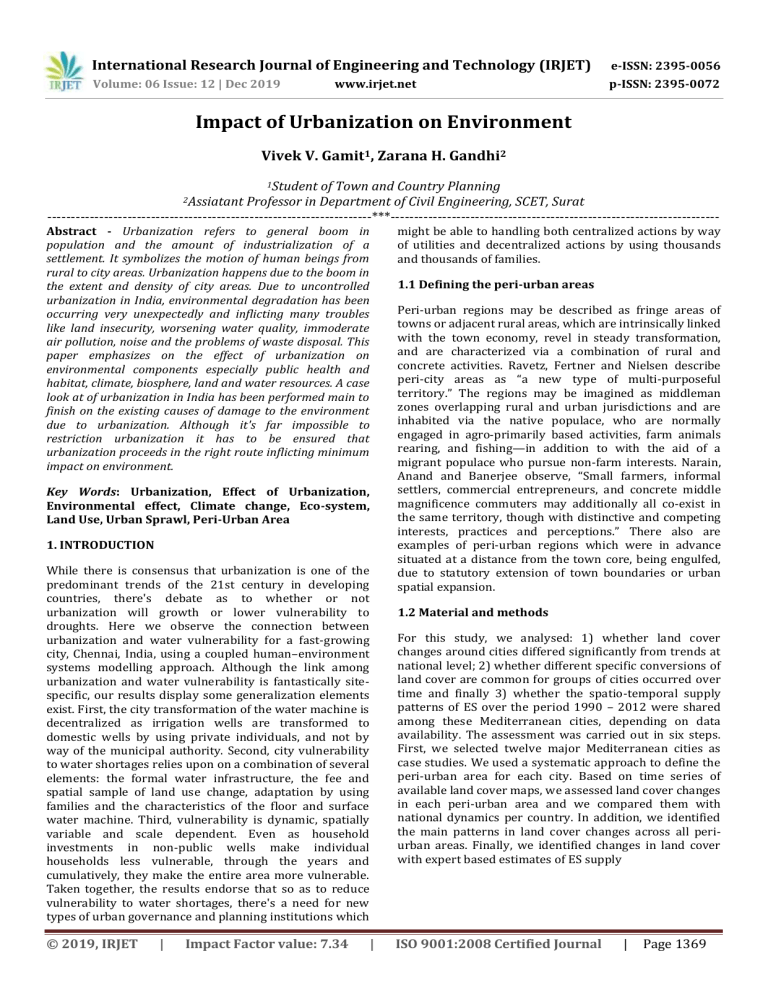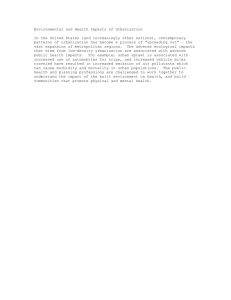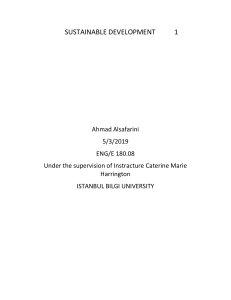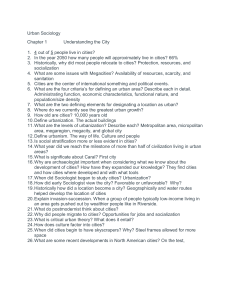IRJET- Impact of Urbanization on Environment
advertisement

International Research Journal of Engineering and Technology (IRJET) e-ISSN: 2395-0056 Volume: 06 Issue: 12 | Dec 2019 p-ISSN: 2395-0072 www.irjet.net Impact of Urbanization on Environment Vivek V. Gamit1, Zarana H. Gandhi2 of Town and Country Planning Professor in Department of Civil Engineering, SCET, Surat ---------------------------------------------------------------------***---------------------------------------------------------------------2Assiatant 1Student Abstract - Urbanization refers to general boom in population and the amount of industrialization of a settlement. It symbolizes the motion of human beings from rural to city areas. Urbanization happens due to the boom in the extent and density of city areas. Due to uncontrolled urbanization in India, environmental degradation has been occurring very unexpectedly and inflicting many troubles like land insecurity, worsening water quality, immoderate air pollution, noise and the problems of waste disposal. This paper emphasizes on the effect of urbanization on environmental components especially public health and habitat, climate, biosphere, land and water resources. A case look at of urbanization in India has been performed main to finish on the existing causes of damage to the environment due to urbanization. Although it's far impossible to restriction urbanization it has to be ensured that urbanization proceeds in the right route inflicting minimum impact on environment. might be able to handling both centralized actions by way of utilities and decentralized actions by using thousands and thousands of families. 1.1 Defining the peri-urban areas Peri-urban regions may be described as fringe areas of towns or adjacent rural areas, which are intrinsically linked with the town economy, revel in steady transformation, and are characterized via a combination of rural and concrete activities. Ravetz, Fertner and Nielsen describe peri-city areas as “a new type of multi-purposeful territory.” The regions may be imagined as middleman zones overlapping rural and urban jurisdictions and are inhabited via the native populace, who are normally engaged in agro-primarily based activities, farm animals rearing, and fishing—in addition to with the aid of a migrant populace who pursue non-farm interests. Narain, Anand and Banerjee observe, “Small farmers, informal settlers, commercial entrepreneurs, and concrete middle magnificence commuters may additionally all co-exist in the same territory, though with distinctive and competing interests, practices and perceptions.” There also are examples of peri-urban regions which were in advance situated at a distance from the town core, being engulfed, due to statutory extension of town boundaries or urban spatial expansion. Key Words: Urbanization, Effect of Urbanization, Environmental effect, Climate change, Eco-system, Land Use, Urban Sprawl, Peri-Urban Area 1. INTRODUCTION While there is consensus that urbanization is one of the predominant trends of the 21st century in developing countries, there's debate as to whether or not urbanization will growth or lower vulnerability to droughts. Here we observe the connection between urbanization and water vulnerability for a fast-growing city, Chennai, India, using a coupled human–environment systems modelling approach. Although the link among urbanization and water vulnerability is fantastically sitespecific, our results display some generalization elements exist. First, the city transformation of the water machine is decentralized as irrigation wells are transformed to domestic wells by using private individuals, and not by way of the municipal authority. Second, city vulnerability to water shortages relies upon on a combination of several elements: the formal water infrastructure, the fee and spatial sample of land use change, adaptation by using families and the characteristics of the floor and surface water machine. Third, vulnerability is dynamic, spatially variable and scale dependent. Even as household investments in non-public wells make individual households less vulnerable, through the years and cumulatively, they make the entire area more vulnerable. Taken together, the results endorse that so as to reduce vulnerability to water shortages, there's a need for new types of urban governance and planning institutions which © 2019, IRJET | Impact Factor value: 7.34 1.2 Material and methods For this study, we analysed: 1) whether land cover changes around cities differed significantly from trends at national level; 2) whether different specific conversions of land cover are common for groups of cities occurred over time and finally 3) whether the spatio-temporal supply patterns of ES over the period 1990 – 2012 were shared among these Mediterranean cities, depending on data availability. The assessment was carried out in six steps. First, we selected twelve major Mediterranean cities as case studies. We used a systematic approach to define the peri-urban area for each city. Based on time series of available land cover maps, we assessed land cover changes in each peri-urban area and we compared them with national dynamics per country. In addition, we identified the main patterns in land cover changes across all periurban areas. Finally, we identified changes in land cover with expert based estimates of ES supply | ISO 9001:2008 Certified Journal | Page 1369 International Research Journal of Engineering and Technology (IRJET) e-ISSN: 2395-0056 Volume: 06 Issue: 12 | Dec 2019 p-ISSN: 2395-0072 www.irjet.net 2. Effect of Urbanization The effect of urban population growth on peri-urban landscapes is expected to be particularly prominent since urban land cover increases even faster than could be expected from demographic pressure, resulting in substantial land use conversions. Urban populations in countries around the Mediterranean Sea increased from 152 million to 315 million between 1970 and 2010 (an average rate of 1.9 % per year). By 2030, the Mediterranean Basin will be the global biodiversity hotspot with the highest percentage of urban land (5%). Urbanization rates have been accelerated by environmental change; for example, intense drought conditions contributed to a rural exodus in Morocco between 1980 and 1990, and in Algeria and Tunisia in 1999. Tourism and housing development have led to the development of infrastructure close to coastal areas and near culturally important cities. Mediterranean cities are considered attractive places to settle for retirees from northern Europe and for return migrants to the Maghreb country. The present world experiences rapid price of urbanization and it's miles becoming the hub of comprehensive development in socio-financial, cultural and other aspects characterized by way of shifting of rural populace to city areas. The extraordinary urbanization mainly in developing countries like India and China consequences gradual boom of population density in urban areas, the continuous growth of city land, rapid transformation of rural panorama into city panorama, adjustments in financial sports from agricultural to non-agricultural monetary sports (number one to secondary or tertiary economic sports) and the general alteration in consumption behavior and residing of general in urban surroundings. Although many benefits (socio-monetary, cultural) are attained by using the method of urbanization among city residents but some of boundaries are constructed in natural surroundings by means of reworking the urban landscape and affecting UAHB (Urban Atmosphere Hydrosphere and Biosphere). Recently, all over the world, rapid urbanization is one of the major cause of the global environmental and ecological adjustments and therefore, the projection of such adjustments is critical for upcoming decades. The primary questions springing up to the environmentalists and with which global international is worried are (1) a way to slender down the effect of rapid urbanization on the worldwide ecological and environmental change? (2) how to obtain sustainable urban improvement through ecological planning © 2019, IRJET | Impact Factor value: 7.34 | Noise Poppution Air Pollution Water Pollution Pollution in Urban Area Chart -1: Different Types of Pollution Effect of urbanization on environment can cause very high impact on climate change. Due to the climate change, rise in temperature is accurse. 3. CONCLUSION The urban surroundings are an vital factor in figuring out the excellent of life in urban areas and the effect of the city region at the broader surroundings. Some city environmental issues include inadequate water and sanitation, loss of rubbish disposal, and commercial pollution. Unfortunately, reducing the problems and ameliorating their effects at the urban population are expensive. The effect of urbanization is majorly effects on the environment. The emission of the carbon dioxide by the urban area can leads to the climate change. The proper policy can be reducing the effect on environment. REFERENCES 1. Blundell, R.W., Bond, S.R., 1998. Initial conditions and moment restrictions in dynamic panel data models. Journal of Econometrics 87, 115–143. 2. Luers, A.L., Lobell, D.B., Sklar, L.S., Addams, C.L., Matson, P.A., 2003. A method for quantifying vulnerability, applied to the agricultural system of the Yaqui Valley. 3. Norman, J., MacLean, H.L., Kennedy, C.A., 2006. Comparing high and low residential density: lifecycle analysis of energy use and greenhouse gas emissions. Journal of Urban Planning and Development 132, 10-21. 4. United Nations, 2001. World Urbanization Prospects of Population Growth: The 2001 Revision. Population Division, United Nations, 2 United Nations Plaza, Room DC2-1950, New York, NY 10017, USA 5. M. Mohan, Lalit Dagar and B. R. Gurjar, “Preparation and Validation of Gridded Emission Inventory of Criteria Air Pollutants and ISO 9001:2008 Certified Journal | Page 1370 International Research Journal of Engineering and Technology (IRJET) e-ISSN: 2395-0056 Volume: 06 Issue: 12 | Dec 2019 p-ISSN: 2395-0072 www.irjet.net Identification of Emission Hotspots for Megacity Delhi,” Environmental Monitoring and Assessment, Vol. 130, 2007, pp. 323-339 doi:10.1007/s10661-006-9400-9 6. The moderating effects of urbanization on carbon dioxide emissions: A latent class modeling approach, http://dx.doi.org/10.1016/j.techfore.2013.12.025 © 2019, IRJET | Impact Factor value: 7.34 | ISO 9001:2008 Certified Journal | Page 1371


